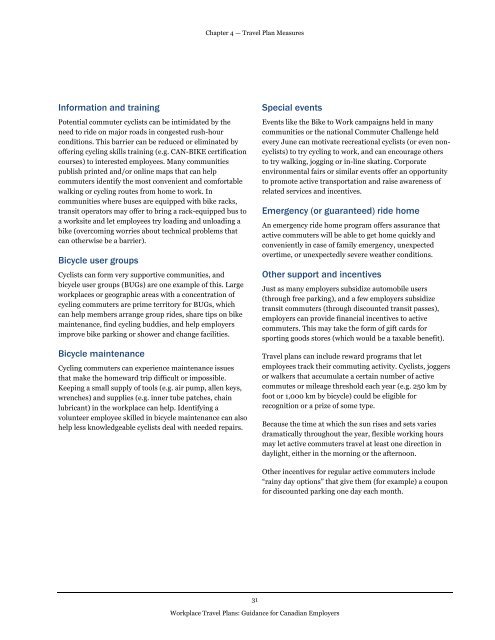Workplace Travel Plans - main body - Final Jan 2010 ENGLISH - FCM
Workplace Travel Plans - main body - Final Jan 2010 ENGLISH - FCM
Workplace Travel Plans - main body - Final Jan 2010 ENGLISH - FCM
Create successful ePaper yourself
Turn your PDF publications into a flip-book with our unique Google optimized e-Paper software.
Chapter 4 — <strong>Travel</strong> Plan Measures<br />
Information and training<br />
Potential commuter cyclists can be intimidated by the<br />
need to ride on major roads in congested rush-hour<br />
conditions. This barrier can be reduced or eliminated by<br />
offering cycling skills training (e.g. CAN-BIKE certification<br />
courses) to interested employees. Many communities<br />
publish printed and/or online maps that can help<br />
commuters identify the most convenient and comfortable<br />
walking or cycling routes from home to work. In<br />
communities where buses are equipped with bike racks,<br />
transit operators may offer to bring a rack-equipped bus to<br />
a worksite and let employees try loading and unloading a<br />
bike (overcoming worries about technical problems that<br />
can otherwise be a barrier).<br />
Bicycle user groups<br />
Cyclists can form very supportive communities, and<br />
bicycle user groups (BUGs) are one example of this. Large<br />
workplaces or geographic areas with a concentration of<br />
cycling commuters are prime territory for BUGs, which<br />
can help members arrange group rides, share tips on bike<br />
<strong>main</strong>tenance, find cycling buddies, and help employers<br />
improve bike parking or shower and change facilities.<br />
Bicycle <strong>main</strong>tenance<br />
Cycling commuters can experience <strong>main</strong>tenance issues<br />
that make the homeward trip difficult or impossible.<br />
Keeping a small supply of tools (e.g. air pump, allen keys,<br />
wrenches) and supplies (e.g. inner tube patches, chain<br />
lubricant) in the workplace can help. Identifying a<br />
volunteer employee skilled in bicycle <strong>main</strong>tenance can also<br />
help less knowledgeable cyclists deal with needed repairs.<br />
Special events<br />
Events like the Bike to Work campaigns held in many<br />
communities or the national Commuter Challenge held<br />
every June can motivate recreational cyclists (or even noncyclists)<br />
to try cycling to work, and can encourage others<br />
to try walking, jogging or in-line skating. Corporate<br />
environmental fairs or similar events offer an opportunity<br />
to promote active transportation and raise awareness of<br />
related services and incentives.<br />
Emergency (or guaranteed) ride home<br />
An emergency ride home program offers assurance that<br />
active commuters will be able to get home quickly and<br />
conveniently in case of family emergency, unexpected<br />
overtime, or unexpectedly severe weather conditions.<br />
Other support and incentives<br />
Just as many employers subsidize automobile users<br />
(through free parking), and a few employers subsidize<br />
transit commuters (through discounted transit passes),<br />
employers can provide financial incentives to active<br />
commuters. This may take the form of gift cards for<br />
sporting goods stores (which would be a taxable benefit).<br />
<strong>Travel</strong> plans can include reward programs that let<br />
employees track their commuting activity. Cyclists, joggers<br />
or walkers that accumulate a certain number of active<br />
commutes or mileage threshold each year (e.g. 250 km by<br />
foot or 1,000 km by bicycle) could be eligible for<br />
recognition or a prize of some type.<br />
Because the time at which the sun rises and sets varies<br />
dramatically throughout the year, flexible working hours<br />
may let active commuters travel at least one direction in<br />
daylight, either in the morning or the afternoon.<br />
Other incentives for regular active commuters include<br />
“rainy day options” that give them (for example) a coupon<br />
for discounted parking one day each month.<br />
31<br />
<strong>Workplace</strong> <strong>Travel</strong> <strong>Plans</strong>: Guidance for Canadian Employers

















